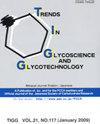硫酸甘聚糖对肠道黏蛋白的影响
IF 0.2
4区 生物学
Q4 BIOCHEMISTRY & MOLECULAR BIOLOGY
引用次数: 0
摘要
在肠道中,粘蛋白作为隔离肠道细菌和宿主的物理屏障。MUC2粘蛋白是一种高度o糖基化的糖蛋白,其聚糖是MUC2功能的重要翻译后修饰。近年来,人们发现MUC2聚糖复合物的特定结构单元具有不同的生理功能。特别是,MUC2聚糖中的GlcNAc和半乳糖的硫酸化对肠道屏障功能至关重要。此外,肠道细菌利用粘蛋白糖链作为营养来源,利用特定的硫酸酯酶,使它们能够在肠道中定植。另一方面,肠道细菌通过诱导糖基转移酶的表达来调节宿主糖基化。根据最近对MUC2聚糖结构和功能的研究,粘蛋白不仅是一种物理屏障,而且是介导与肠道微生物群复杂相互作用的分子。在这篇文章中,我们讨论MUC2粘蛋白的功能和它的糖基化,特别侧重于硫酸化聚糖。本文章由计算机程序翻译,如有差异,请以英文原文为准。
Significance of Sulfated Glycans on Mucins in the Gut
In the intestine, mucins function as a physical barrier separating the gut bacteria and the host. MUC2 mucin is a highly O-glycosylated glycoprotein, and its glycans are an essential post-translational modification for MUC2 function. In recent years, it has been discovered that specific structural units of the complex MUC2 glycans play distinct physiological functions. In particular, the sulfation of GlcNAc and Galactose in MUC2 glycans is essential for intestinal barrier function. Furthermore, gut bacteria utilize mucin sugar chains as a nutrient source by employing specific sulfatase enzymes, allowing them to colonize in the intestine. On the other hand, gut bacteria regulate host glycosylation through the induction of glycosyltransferase expression. In the light of recent studies on the structure and function of MUC2 glycans, mucins are not only functioning as a physical barrier but also as molecules that mediate complex interactions with gut microbiota. In this article, we discuss the function of MUC2 mucin and its glycosylation, with a particular focus on sulfated glycans.
求助全文
通过发布文献求助,成功后即可免费获取论文全文。
去求助
来源期刊

Trends in Glycoscience and Glycotechnology
生物-生化与分子生物学
CiteScore
0.40
自引率
0.00%
发文量
50
审稿时长
>12 weeks
期刊介绍:
TIGG is an international, bilingual journal covering glycoscience and glycotechnology and issued bimonthly since 1989. Since then editors are elected from academia and companies who agree to participate in a volunteer basis for the duration of four years.
TIGG is an official journal of the Japanese Society of Carbohydrate Research.
The journal covers the following categories.
MINIREVIEWS describe recent progress in the fields of glycoscience and glycotechnology. Suggestions are always welcome in the form of a one-page synopsis (double spaced) addressed to the editor-in-chief.
GLYCOTOPICS are short commentaries on the latest papers describing outstanding findings with background.
GLYCODEBUTS introduce distinguished PhD theses or outstanding works of young scientists over the world in glycosciences and glycotechnologies.
GLYCOFORUM is for our readers who wish to submit comments on scientific or social matters related to glycoscience and glycotechnology.
LETTERS TO TIGG are for readers who wish to discuss contributions appearing in TIGG or matters related to FCCA.
 求助内容:
求助内容: 应助结果提醒方式:
应助结果提醒方式:


